PsychNewsDaily Publishers
100 Summit Drive
Burlington, MA, 01803
Telephone: (320) 349-2484
PsychNewsDaily Publishers
100 Summit Drive
Burlington, MA, 01803
Telephone: (320) 349-2484
Cats can safely enjoy small amounts of cooked chicken, canned tuna, steamed carrots, pumpkin puree, blueberries, cooked salmon, boiled eggs, green beans, cheese, rice, sweet potato, and peas.

Ever feel tempted to share a snack with your cat? Not every food on your plate is safe, but some human foods can add variety, a few extra nutrients, and a safe treat to your cat’s day.
Knowing which options work best lets you avoid risks while still giving your cat something special.
Here’s a list of everyday foods cats can enjoy in small amounts. You’ll see simple choices like lean meats, fruits, and veggies, plus quick tips on serving them safely.
Ready to add some excitement to your cat’s diet? Let’s dive in.

You can safely offer small pieces of plain cooked chicken breast to your cat. Chicken gives lean protein that supports muscle health and keeps your cat energized.
Always cook the chicken fully and remove any bones. Bones can splinter and injure your cat, while undercooked meat might carry harmful bacteria.
Skip the seasoning, sauces, or oils. Garlic, onion, and lots of salt are dangerous for cats. Just keep it plain.
Think of chicken breast as a treat or a little extra, not a replacement for your cat’s main food.
Start slow with small amounts. Some cats have sensitive stomachs, so it’s smart to introduce new foods gradually.
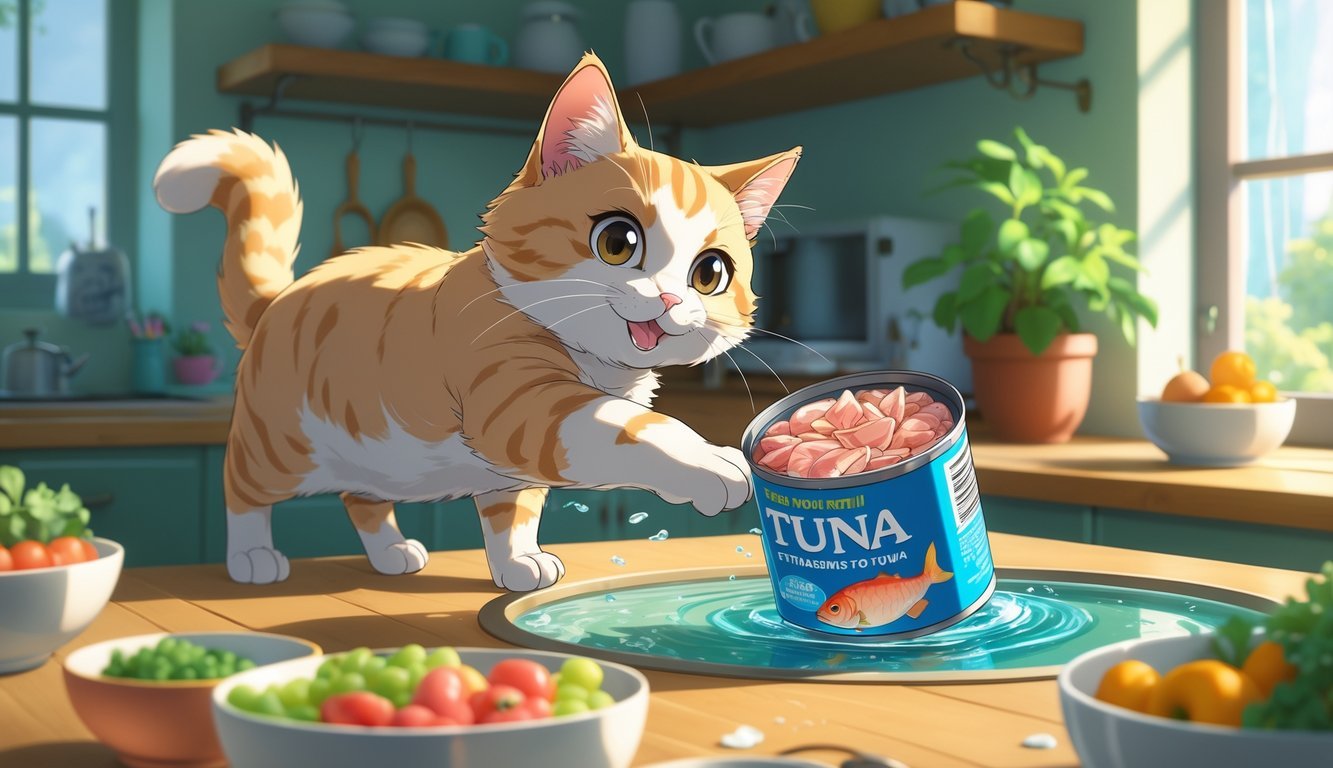
A small amount of canned tuna in water can make a tempting treat. Most cats love the smell and taste.
Pick tuna packed in water with no added salt or flavoring. Tuna in oil or with seasonings isn’t great for cats and could upset their stomach.
Tuna gives some protein, but it doesn’t have everything your cat needs for daily meals. Use it only as an occasional snack.
Too much tuna can lead to mercury buildup or picky eating. Keep portions small and mix things up with other safe foods.
If you want to treat your cat, a spoonful of plain tuna in water now and then is just fine. Just don’t make it a daily thing.

You can share small pieces of steamed carrots with your cat. Steaming softens the carrots, so they’re easier to chew and digest.
Raw carrots are too hard and could upset your cat’s stomach.
Carrots have fiber, which helps with digestion. They also contain beta-carotene, which helps the body make vitamin A.
Cats mostly get vitamin A from meat, but a little extra from carrots won’t hurt.
Always serve carrots plain—no butter, oil, salt, or seasoning. These extras can cause stomach issues.
Cut carrots into tiny bites and use them as a treat, not a main food. Cats are obligate carnivores and still need meat for proper nutrition.
If your cat likes the taste, carrots can be a low-calorie reward. Introduce them slowly to check for any stomach upset.
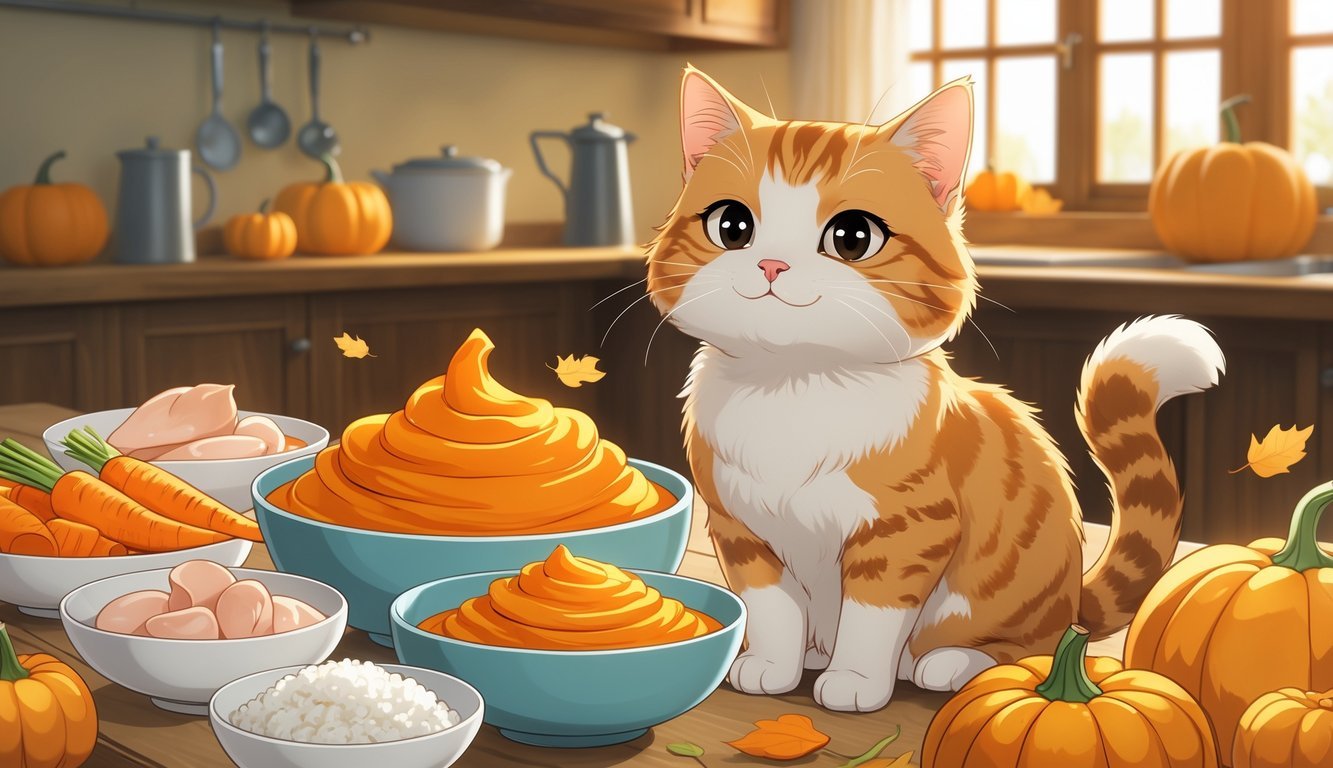
Plain pumpkin puree is safe for cats in small amounts. Many cats tolerate it well and some even enjoy it.
Pumpkin puree has natural fiber. If your cat deals with constipation or mild digestive issues, a little pumpkin can help things move along.
Stick to plain, cooked pumpkin puree with no sugar, salt, or spices. Pumpkin pie filling isn’t safe—it usually has harmful ingredients.
Try mixing a small spoonful into your cat’s regular food. Start tiny and watch for any stomach upset.
Pumpkin puree works best as a treat or supplement. If your cat has health issues, check with your vet before adding it to meals.
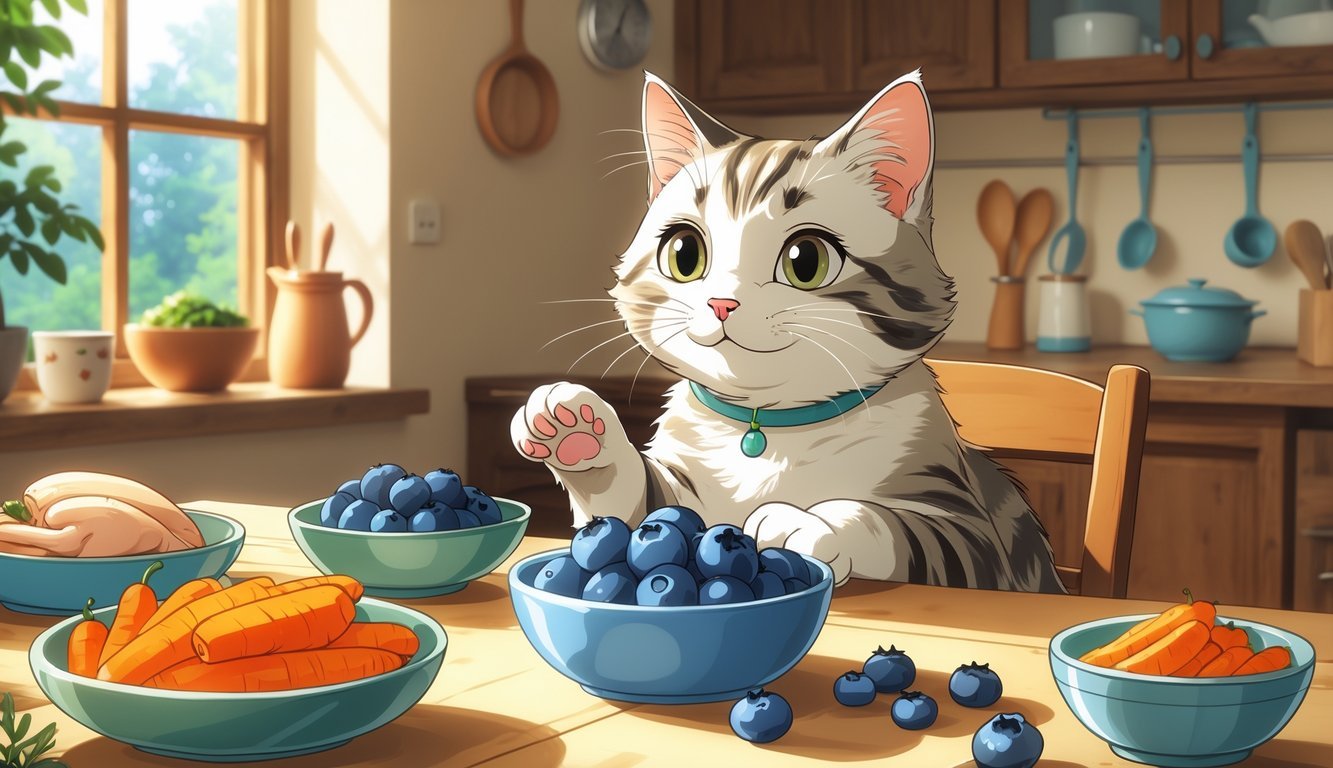
Surprisingly, cats can eat blueberries in small amounts. Even though cats need meat for most of their nutrition, a couple of blueberries can be a safe treat.
Blueberries have fiber, water, and vitamins that are good for people. For cats, they don’t add much nutrition, but they’re not harmful in moderation.
Start with one or two blueberries. Watch for any signs of stomach upset, like vomiting or diarrhea.
Not all cats like blueberries, so don’t be shocked if yours ignores them.
Serve blueberries plain, with no added sugar or flavoring. Fresh or frozen berries are best.
Skip blueberry-flavored foods—they usually have ingredients that aren’t safe for cats.
A few blueberries now and then can add variety to your cat’s treats. But always make sure your cat’s main food is a high-quality cat food.
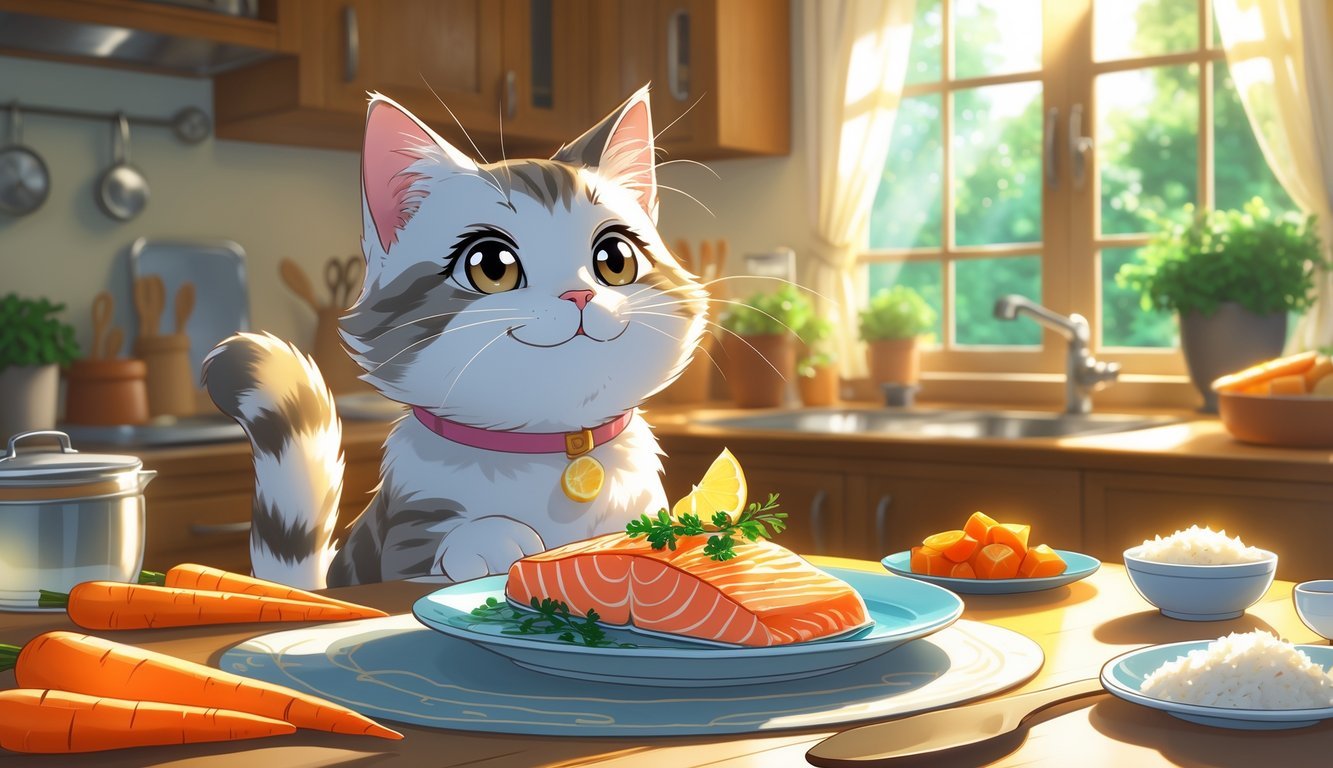
You can offer small pieces of cooked salmon to your cat. Salmon gives protein and healthy fats that help muscles, skin, and coat.
Keep the salmon plain, with no seasoning, oils, or sauces. Even a little salt or garlic can upset a cat’s stomach.
Always remove all bones before serving. Tiny bones can be sharp and dangerous.
Think of salmon as a treat, not a main meal. Too much can mess with your cat’s diet.
Most cats love the taste, but just a small bite now and then is enough.
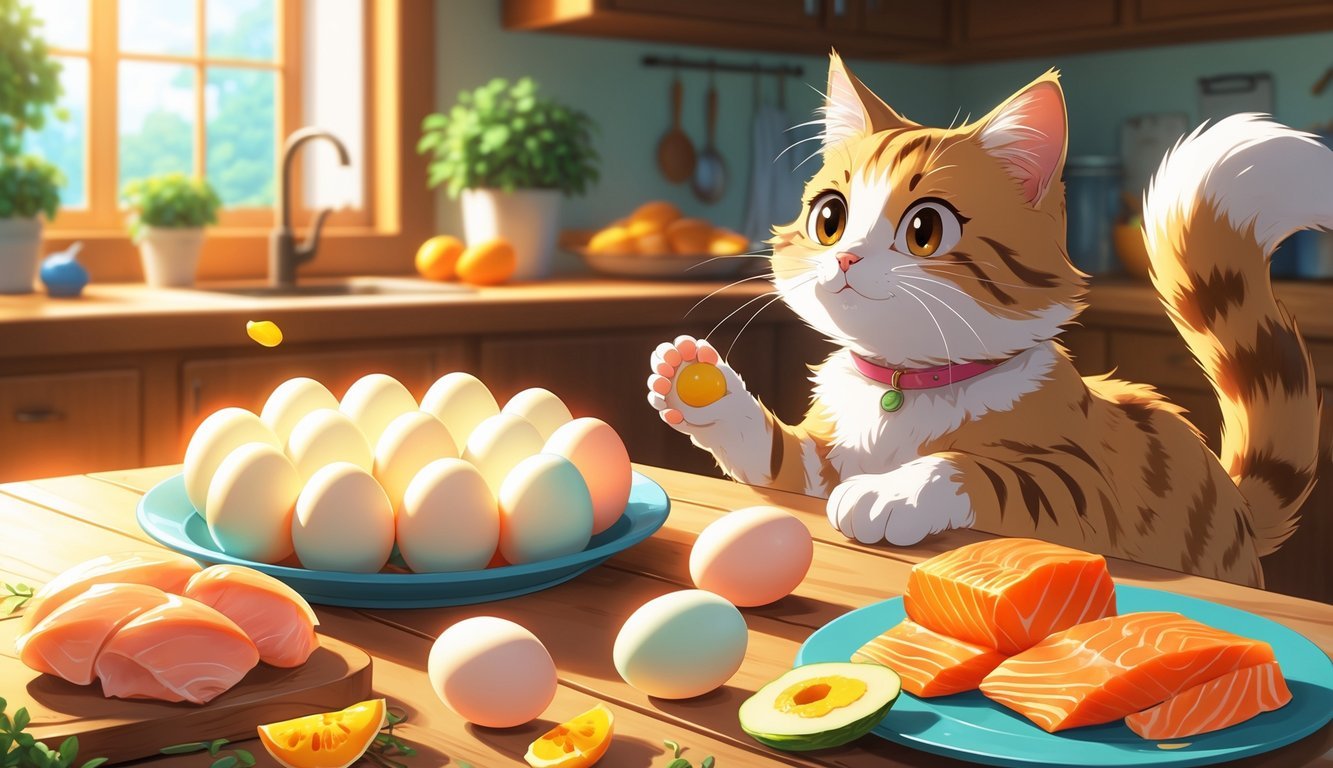
A little boiled egg can be a safe treat for your cat. Eggs have protein and amino acids that support muscles and health.
Serve eggs plain and fully cooked. Skip the salt, butter, or seasoning.
Give boiled eggs only as an occasional treat. Too much egg could cause digestive problems or extra calories.
Cut the egg into small pieces before giving it to your cat. This makes eating safer and easier.
Never feed raw eggs—they can carry bacteria like salmonella, which can make both of you sick.

Plain cooked green beans are safe for cats. They’re not toxic, and some cats like the light crunch.
Make sure beans are free from salt, butter, or seasonings.
Green beans add a bit of fiber, which can help digestion and make cats feel full without lots of calories.
Some vets even suggest green beans as a snack for overweight cats.
You can use frozen or fresh beans—just cook them until soft and let them cool.
Canned green beans work if they have no added salt.
Start with small pieces to see if your cat likes them. Not all cats care for veggies, but a few bites are safe now and then.
Always treat green beans as an occasional snack. Cats still need animal protein for health.
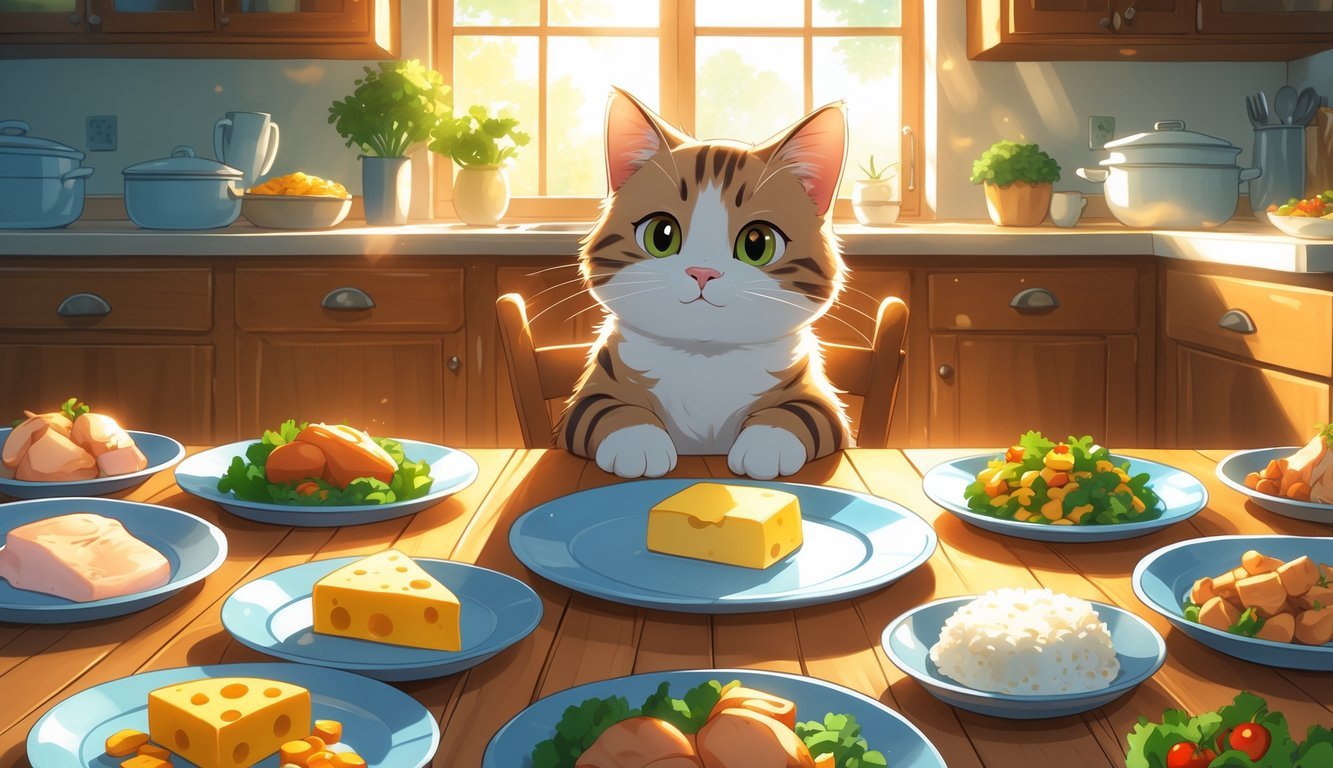
You can give your cat a bit of cheese as a treat. Lots of cats like the taste, and it’s a fun change.
Most adult cats are lactose intolerant, so too much dairy can upset their stomach.
If you try cheese, start tiny and watch how your cat reacts.
Cheddar and cottage cheese are usually easier for cats to handle. Avoid soft cheeses with strong flavors or seasonings.
Cheese doesn’t add much nutrition compared to regular cat food. It’s just a snack.
If your cat gets diarrhea or gas, skip the cheese next time. Every cat’s different, so test carefully and keep portions small.
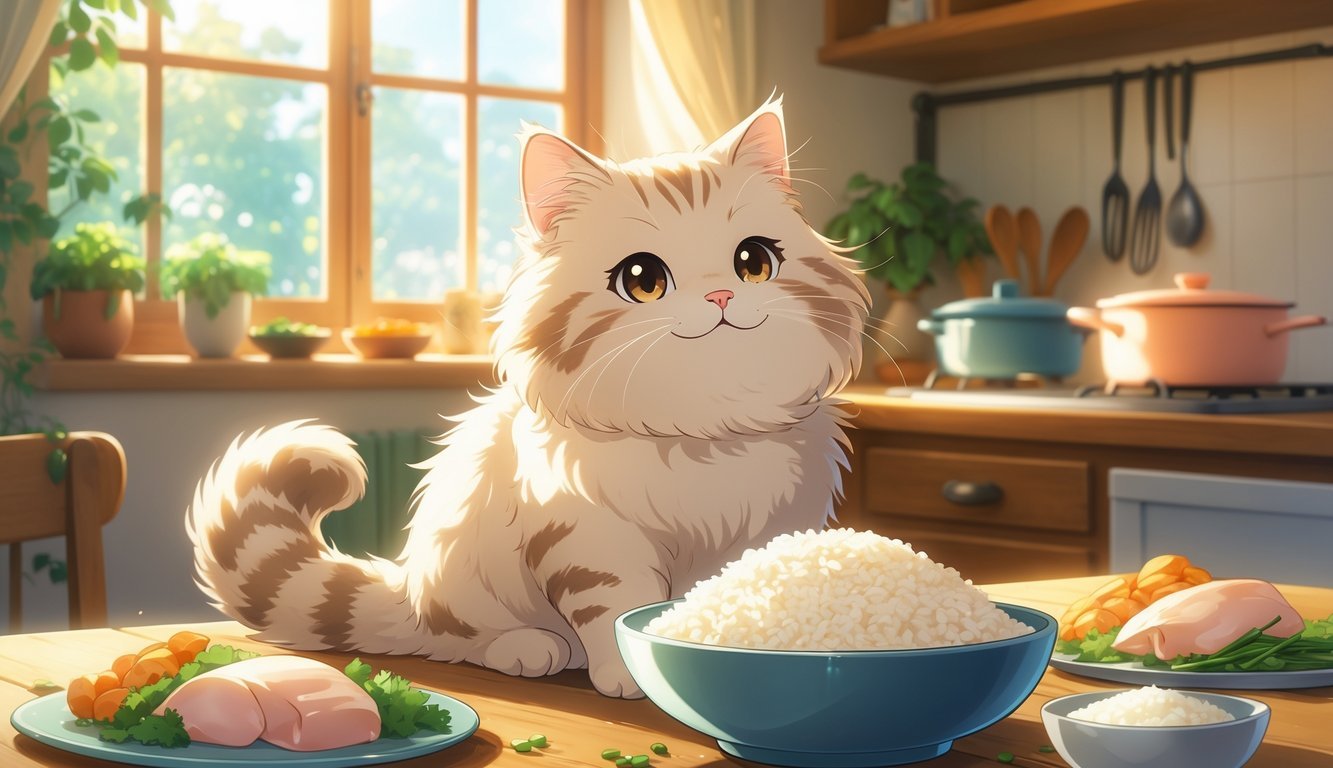
Plain, cooked rice is safe in small amounts. Sometimes it can help settle a mild upset stomach.
Make sure the rice is fully cooked and soft. Uncooked rice is tough to digest and can cause discomfort.
Keep portions tiny. Rice should never replace your cat’s main diet—cats need protein from meat.
Skip butter, oil, salt, or seasoning. These extras can upset your cat’s stomach.
Some vets suggest mixing a spoonful of plain rice with boiled chicken for mild diarrhea. It’s easier on their digestive system.
If your cat ignores rice, don’t worry. Many cats just prefer meat anyway.
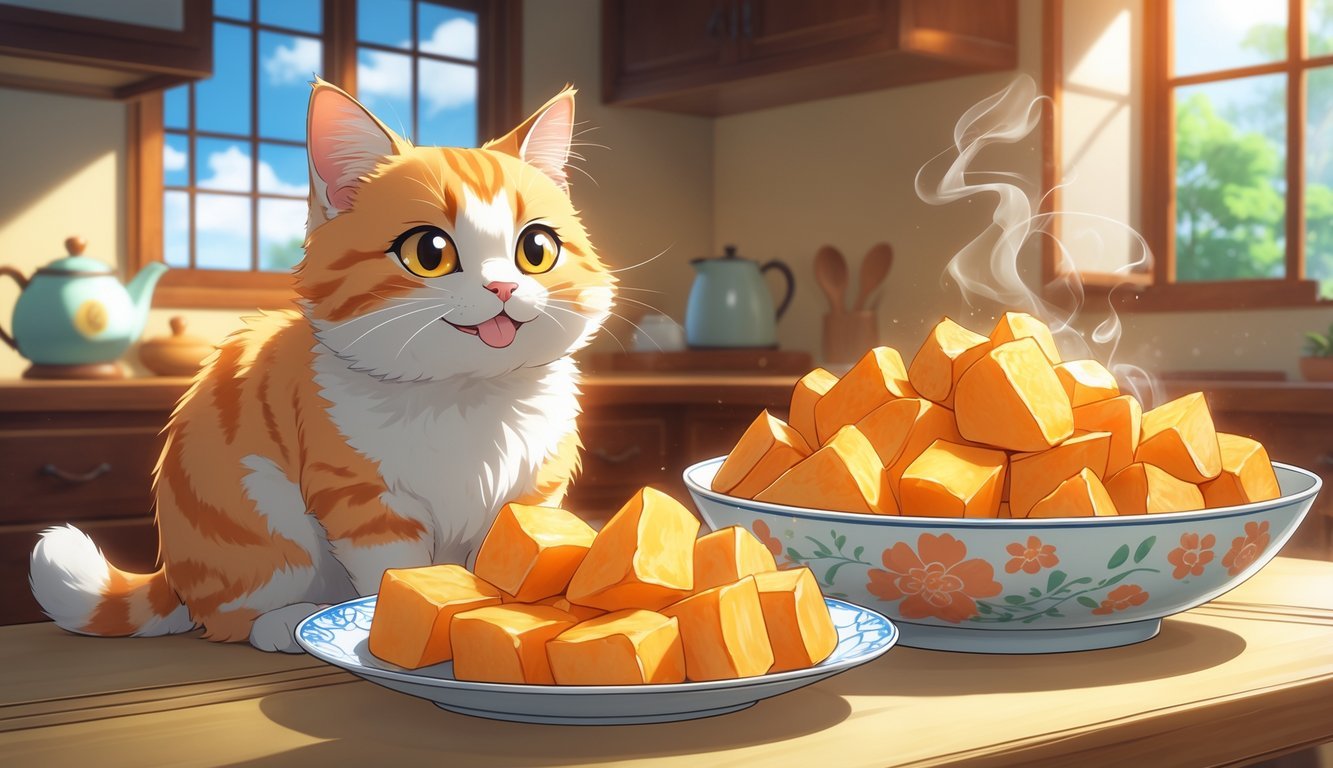
You can give your cat a little cooked sweet potato as a treat. Sweet potatoes aren’t toxic, and if they’re plain and soft, they’re generally safe.
Cats don’t need sweet potatoes for nutrition. They’re obligate carnivores, so their bodies work best with nutrients from meat.
Too much sweet potato can upset digestion because of extra fiber and carbs.
If you offer sweet potato, make sure it’s fully cooked and mashed or cut into small pieces. No butter, oil, salt, or seasonings—keep it plain.
Think of sweet potato as a rare snack, not a regular food. A bite or two once in a while is fine, but it shouldn’t take the place of your cat’s normal diet.
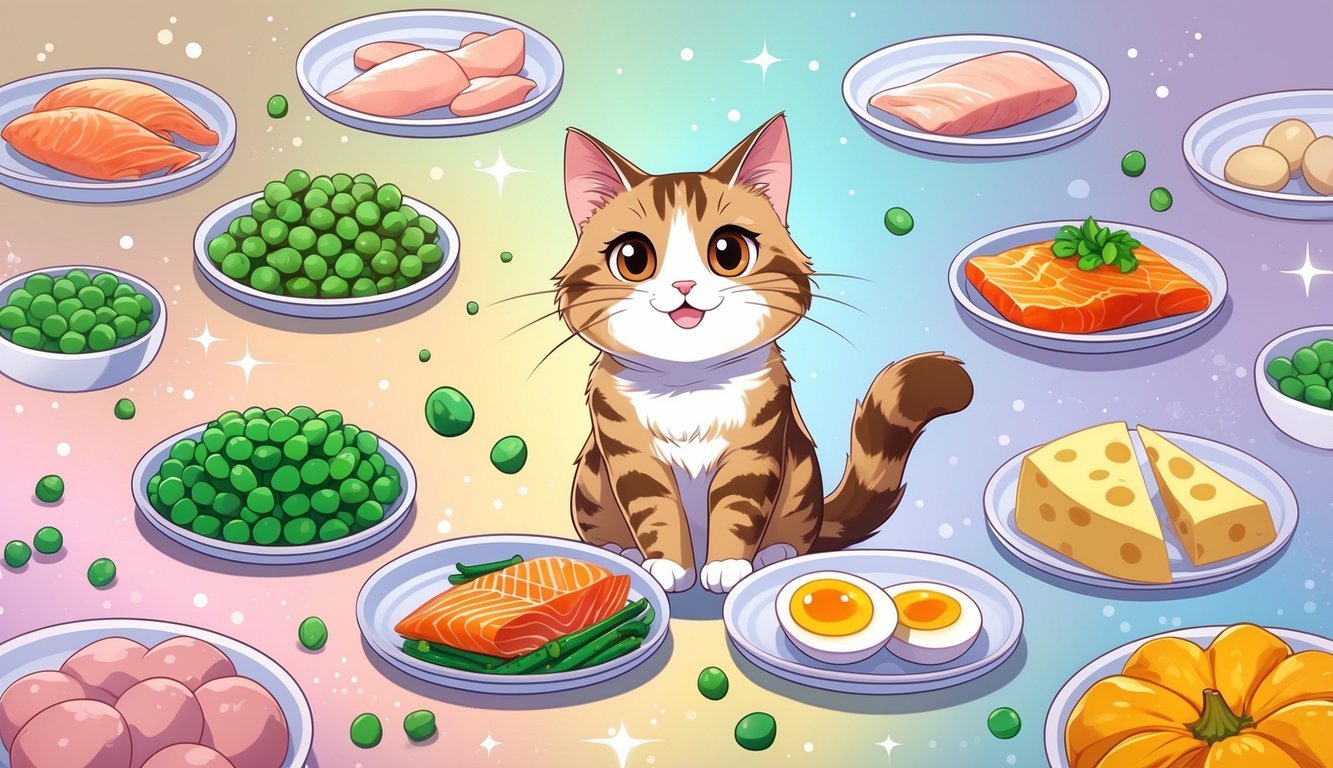
You can safely give your cat plain peas now and then, just in small amounts. Peas aren’t toxic, and you’ll even spot them in some commercial cat foods.
They bring fiber, vitamins, and a hint of plant protein to the table. While these nutrients can help with digestion and add a little variety, cats don’t actually need peas for their health.
Since cats are obligate carnivores, they get basically everything they need from meat. Peas should stay as an occasional treat, not something you feed every day.
Try offering fresh, cooked, or even frozen peas, but skip the salt, butter, or any seasonings. Canned peas usually have extra sodium, so it’s better to avoid those.
Start with just a pea or two and see what your cat thinks. Some cats love the taste or the texture—others might just turn up their noses.
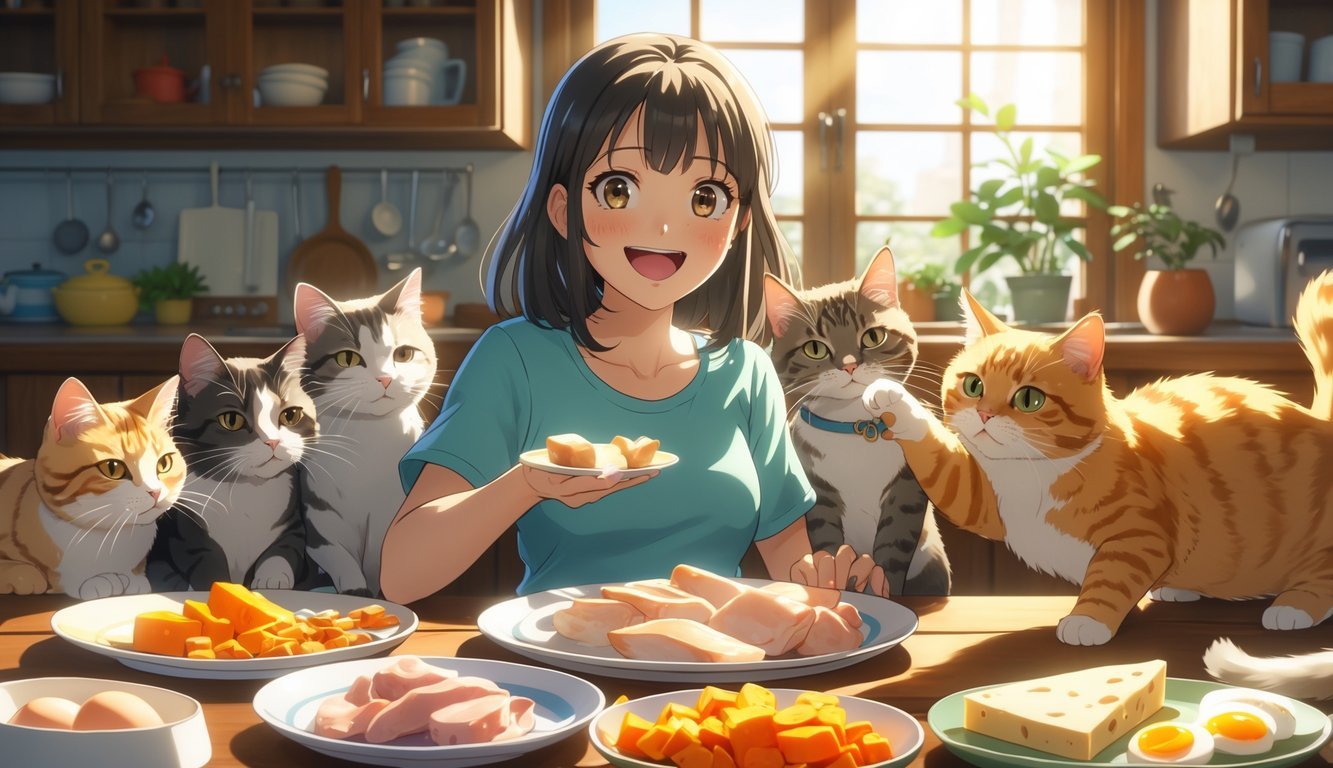
Cats can try certain human foods as treats, but you’ve got to be careful about how you share them. Portion size, how you prep the food, and watching for any odd reactions all matter for your cat’s health.
When you give your cat a new food, start with just a tiny amount. A teaspoon or less is usually enough for the first go.
This way, you can see how your cat reacts without upsetting their stomach.
Serve plain, cooked foods—don’t add seasoning, oils, or sauces. For example, plain boiled chicken works, but fried or spiced chicken doesn’t.
Cats have sensitive stomachs, so even a bit of salt or spice might cause trouble.
Try one new food at a time. If you offer a bunch of new things at once, you won’t know what caused a reaction if something goes wrong.
Wait a few days before introducing another food.
Keep an eye out for changes in appetite, stool, or behavior. If your cat vomits, gets diarrhea, or seems really tired, stop the new food right away.
Here are a few safe foods to start with:
Some cats develop allergies or sensitivities, even to foods that seem safe. The most common triggers are dairy, fish, beef, chicken, and grains.
If your cat reacts badly, one of these might be the culprit.
Allergic reactions can show up as itchy skin, frequent ear infections, vomiting, or soft stools. Sometimes, symptoms don’t appear until hours or days later.
Try keeping a simple food journal. Write down what you feed your cat and note any odd symptoms—this can help you spot patterns.
Steer clear of foods known to be toxic. Don’t give your cat onions, garlic, chocolate, grapes, or raisins. Even a small bit can cause harm.
If you think your cat has a food allergy, stop feeding the new food and call your vet. They’ll help you figure out what happened and suggest safe alternatives.
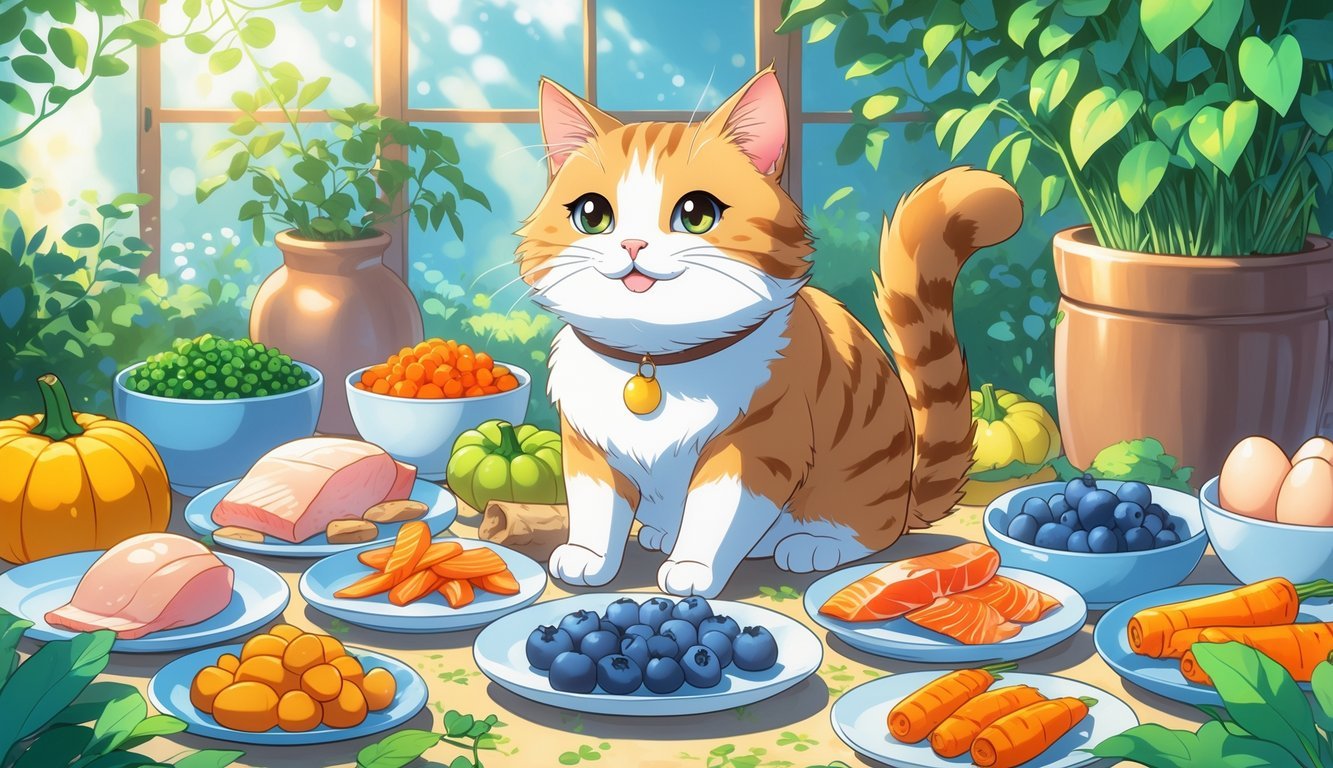
When you share safe human foods with your cat, you’re giving them extra nutrients that can help their health. The right foods add protein, vitamins, or hydration—and honestly, it just makes meals a little more fun.
Cats need protein from meat most of all. Foods like chicken, turkey, and salmon give them amino acids for muscle and energy.
Some human foods offer vitamins and minerals too. For example:
Hydration matters, too. Fresh foods like cucumber or a small piece of melon contain water, which helps cats who don’t drink much on their own.
Even tiny servings of these foods add variety and nutrients, as long as you stick to plain, unseasoned options. Avoid salt, spices, or oils—cats’ stomachs just aren’t built for those.
Cats have pretty tiny stomachs, so how much you feed them really does matter. As a general rule, keep human foods as treats—they shouldn’t make up more than 10% of your cat’s daily calories.
Try offering just a small bite, maybe ½ teaspoon to 1 teaspoon, depending on what you’re sharing. For meats, just a little cooked piece works. With fruits or veggies, a couple of bites is plenty.
Here’s a quick guide:
| Food Type | Safe Serving Size | Notes |
|---|---|---|
| Cooked meat | 1–2 small bites | No bones, skin, or seasoning |
| Pumpkin | ½–1 teaspoon | Plain, cooked, or canned |
| Blueberries | 1–2 berries | Fresh or frozen, no sugar |
Keep servings small and only give them once in a while. That way, your cat can try new things without risking weight gain or an upset stomach.